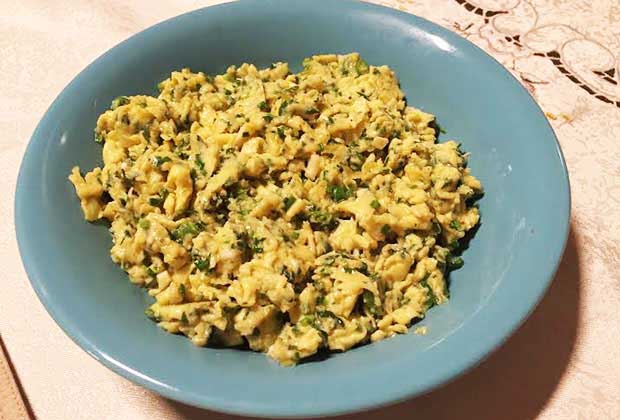Akoori’s Evil Twin – Anda Bhurji!
- By Perzen PatelLoading...
- | 2 Oct 2015 5:25 AM GMT
 X
X
 A green garlic akoori could be your new breakfast favourite. Photo: Perzen Patel
A green garlic akoori could be your new breakfast favourite. Photo: Perzen Patel
Not always will the people of Mumbai know much about the history of the Parsis.
What they do however know a lot about is our two greatest food contributions – Dhansak and Akoori. While Brittania and the several Parsi schools scattered around the city have played their part in popularising Dhansak, Akoori’s claim to fame is its inclusion on the menu of every Irani café that has existed to date.
Made with finely chopped onions, tomatoes, spices and whisked eggs, Akoori is quite similar to Mumbai’s Anda-Bhurji that’s available on the street and in restaurants. So, it is understandable that the uninitiated would consider Akoori and Bhurji to be twins. The reality, however, is that the Bhurji is actually Akoori’s evil twin!
I recently read an article on Parsi Khabar that explained the difference quite eloquently – “Akoori is runny but not loose, it lovingly spreads goodwill all over the plate unlike its country cousin, the Bhurji, which petulantly sits in a heap, as if it is upset with the plate.” When I showed this quote to my blue-blooded Parsi friends, all they could do was laugh while nodding approval.
So, what must you do to turn the evil twin into a delightful Akoori? It’s simple! Firstly, use ghee not oil to given the Akoori its rich texture. Secondly, pour in the love by continuously whisking the mixture with a balloon whisk as it cooks on the stove. And, most importantly, remember that Akoori is about celebrating the egg, not the onion so you mustn’t hold back on the eggs under any circumstance!
to given the Akoori its rich texture. Secondly, pour in the love by continuously whisking the mixture with a balloon whisk as it cooks on the stove. And, most importantly, remember that Akoori is about celebrating the egg, not the onion so you mustn’t hold back on the eggs under any circumstance!
Humour aside, another reason that makes Akoori stand out from the Bhurji, is also because of its versatility. While the Bhurji is almost always made with traditional Indian spices one can have different kinds of Akoori.
There is the luxurious Bharuchi Akoori made with Sali and oodles of ghee (traditionally as much as 500 gm ghee to feed six!), but no spices or the Leela Lasoon (green garlic) Akoori, which is a winter breakfast delight in many Parsi homes. If you’re feeling indulgent, there’s also the Mawa Ni Akoori made with almonds, cashews, raisins and chironji seeds. Or, the slightly strange but delicious Ripe Mango Akoori – a great way of using up those excess mangoes when you don’t know any other ‘creative’ thing you can do with them.
 Add some zing to your regular akoori with green garlic. Photo: Perzen Patel
Add some zing to your regular akoori with green garlic. Photo: Perzen Patel
While I always preferred the standard masala Akoori as a child, I’ve recently changed teams and now bat for the Leela Lasoon Akoori. I recently spotted green garlic in the markets again, which means you can try making some at your home too. Here’s how you can make it.
again, which means you can try making some at your home too. Here’s how you can make it.
Recipe for Leela Lasoon Akoori (Serves 2)
Ingredients
2 heaped tbsp ghee or butter
2 green chilies slit and seeded
1 small bunch fresh green garlic chopped
4 eggs
1 tbsp chopped coriander leaves
Salt to taste
Method
1. Heat ghee and fry chilies with garlic on a medium flame. Do not allow to brown.
2. As soon as the garlic aroma floats out, break eggs directly into the pan and add the salt.
3. Continuously whisk the eggs until they start to set.
4. Sprinkle with chopped coriander and remove from the fire when the eggs are still loose – they will continue cooking.
5. Serve at once with Brun Pav.
Bawi by birth and foodie by life, Perzen Patel is Mumbai's Bawi Bride. While she didn't know how to cook even a simple Parsi Dhandar until she got married, Perzen is now on a mission to spread happiness through Dhansak. When she is not writing, Perzen runs a full-fledged Parsi catering service, organises food experiences and also offers cooking classes.
Follow Perzen on Twitter @BawiBride




